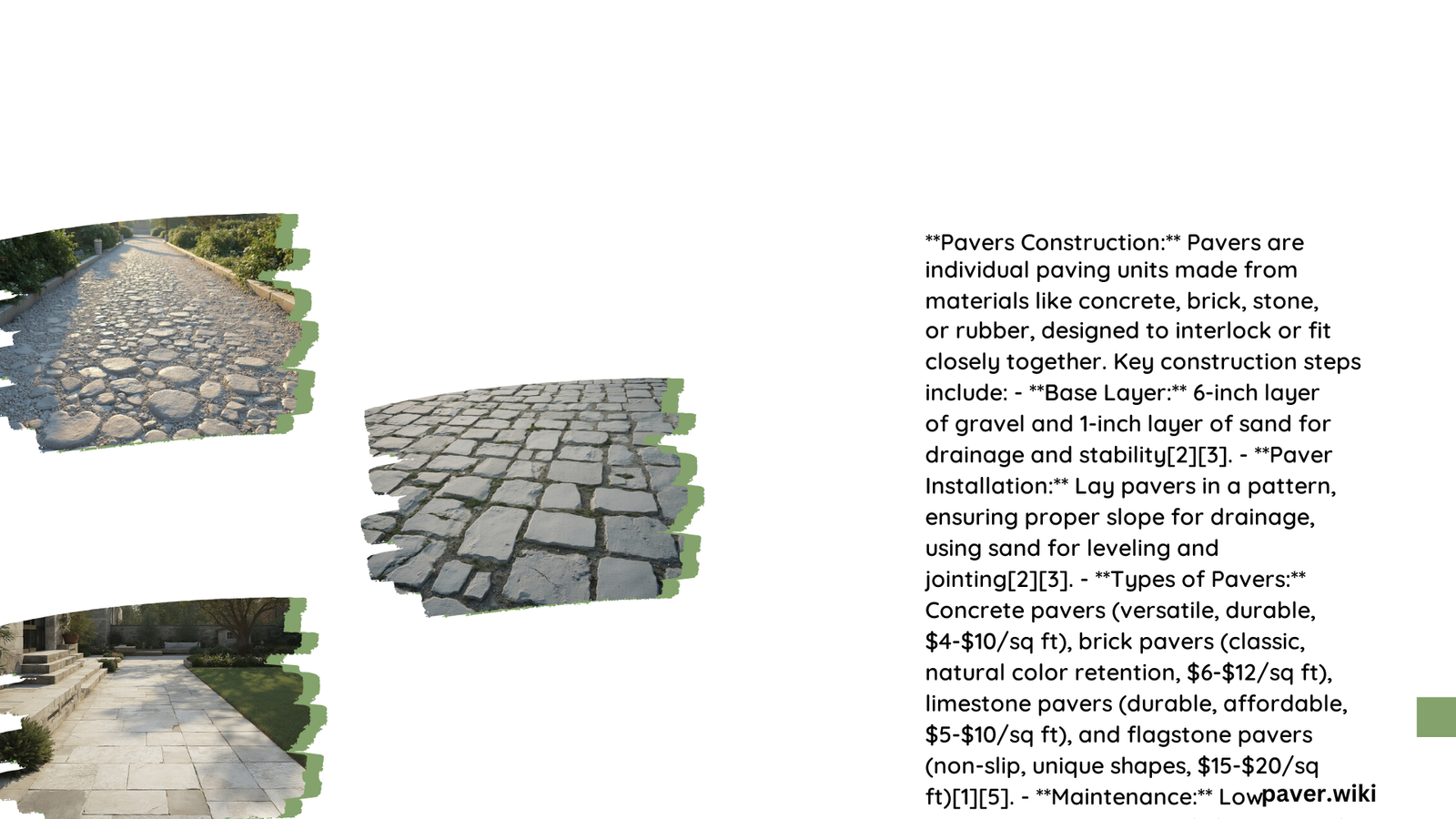Pavers construction is a versatile and durable method for creating outdoor surfaces such as patios, driveways, and walkways. This process involves laying individual paving units on a prepared base to form a stable, attractive, and long-lasting surface. Pavers offer numerous benefits, including easy installation, a wide range of design options, and the ability to withstand various weather conditions. This guide will explore the techniques, materials, costs, and maintenance aspects of pavers construction.
What Are the Main Techniques for Pavers Construction?
Pavers construction involves several key techniques, each suited to different applications and requirements:
Dry Laying (Sand Set Pavers)
This method is popular for its cost-effectiveness and flexibility:
- Excavate and compact the soil (4-6 inches for pedestrian areas, 6-8 inches for pool decks, 8-12 inches for driveways)
- Install geotextile fabric for weed prevention and drainage
- Add a 4-inch layer of crushed gravel, compacted to 95% Proctor density
- Apply a 1-2 inch layer of coarse sand, leveled with a screed board
- Lay pavers tightly, tapping with a rubber mallet
- Fill joints with masonry or polymeric sand
Pros:
– Cost-effective
– Allows for adjustments
– Good drainage
Cons:
– Less stable for heavy traffic
– Requires regular maintenance
Best for: Walkways, patios, light traffic areas
Wet Setting (Mortar Set Pavers)
This technique offers high stability and durability:
- Prepare and cure a concrete base
- Apply a layer of mortar
- Set pavers into the mortar
- Fill joints with mortar or polymeric sand
Pros:
– Highly stable and durable
– Suitable for heavy traffic
– Long-lasting
Cons:
– More expensive
– Less flexible
– Requires specialized labor
Best for: High-traffic areas, commercial spaces
Bitumen Set Pavers
A middle-ground option balancing cost and stability:
- Install compacted aggregate base
- Lay concrete or bituminous binder base
- Apply asphaltic bitumen and tack coat
- Set pavers into bitumen
- Fill joints with sand
Pros:
– Moderate cost and stability
– Suitable for moderate traffic
Cons:
– Less durable than mortar set
– Requires specific materials and labor
Best for: Residential driveways, parking lots
What Are the Most Durable Materials for Pavers Construction?

The choice of material significantly impacts the durability and aesthetics of your pavers construction:
| Material | Lifespan | Cost per Sq Ft | Maintenance | Durability |
|---|---|---|---|---|
| Concrete | 20-30 years | $3-$10 | Regular cleaning, occasional sealing | Good, may crack over time |
| Brick | 25-50 years | $5-$15 | Regular cleaning, joint filling, sealing | Excellent, classic look |
| Natural Stone | 50+ years | $10-$30 | Regular cleaning, sealing, joint filling | Superior, unique appearance |
How Much Does Pavers Construction Cost?
The total cost of pavers construction varies based on materials, installation method, and labor:
Material Costs
- Concrete Pavers: $3-$10 per sq ft
- Brick Pavers: $5-$15 per sq ft
- Natural Stone Pavers: $10-$30 per sq ft
Labor Costs
- Dry Laying: $2-$5 per sq ft
- Wet Setting: $5-$10 per sq ft
- Bitumen Setting: $3-$7 per sq ft
Equipment Costs
- Plate Compactor Rental: $100-$300 per day
- Screed Board: $20-$50
- Rubber Mallet: $10-$30
Total Cost Estimates (per sq ft)
- Concrete Pavers (Dry Laying): $5-$15
- Brick Pavers (Dry Laying): $7-$20
- Natural Stone Pavers (Dry Laying): $12-$35
- Concrete Pavers (Wet Setting): $8-$20
- Brick Pavers (Wet Setting): $10-$25
- Natural Stone Pavers (Wet Setting): $15-$40
What Are Essential Maintenance Tips for Pavers Construction?
Proper maintenance ensures the longevity and appearance of your pavers:
- Regular Cleaning
- Sweep debris regularly
- Use mild detergent and water for cleaning
-
Avoid harsh chemicals
-
Sealing
- Apply sealant annually or bi-annually
-
Use sand binding sealant for joint protection
-
Repairs
- Fill gaps with polymeric or masonry sand
-
Replace damaged pavers as needed
-
Common Issues and Solutions
- Weed Growth: Use polymeric sand and regular sealing
- Stains: Clean immediately and apply sealant
- Settling: Ensure proper base compaction and leveling
By following these guidelines for pavers construction, you can create durable, attractive outdoor surfaces that will last for years to come. Whether you choose concrete, brick, or natural stone, proper installation and maintenance are key to maximizing the lifespan and beauty of your paved areas.
References:
1. How to Install Pavers: Step-by-Step Guide to Laying Pavers
2. Concrete Paver Installation
3. Brick Paver Installation Methods
4. 10-Step Guide to Installing Pavers
